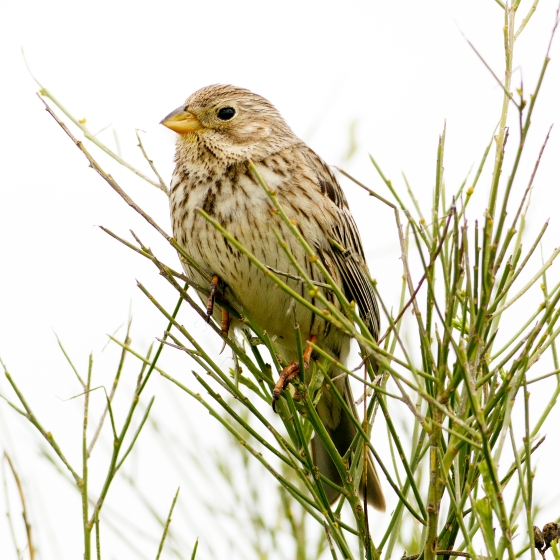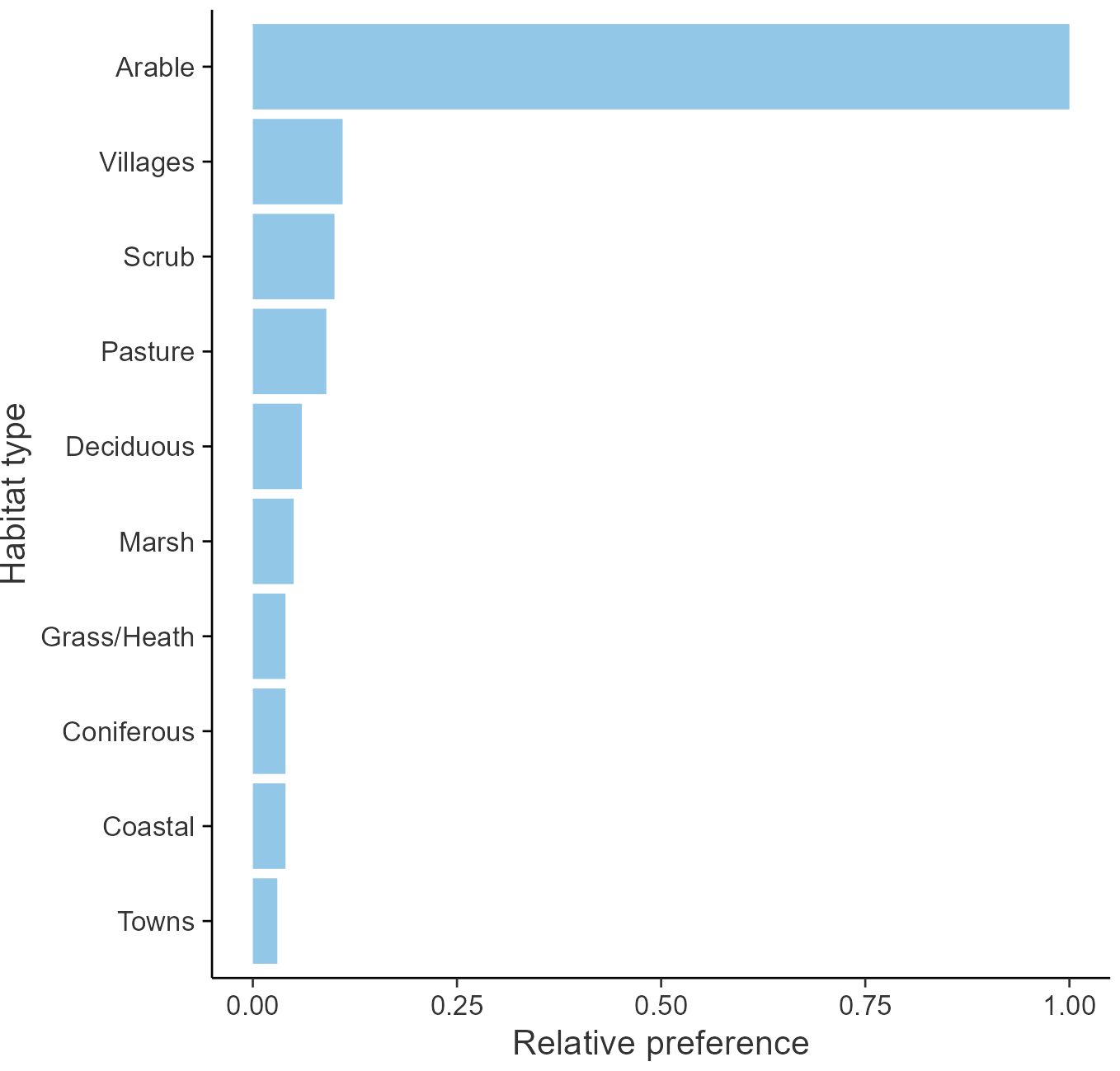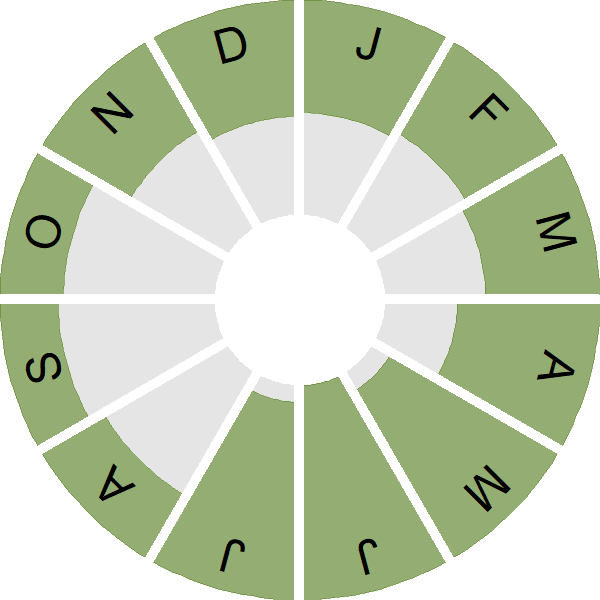Corn Bunting

Introduction
This dumpy, brown bunting has undergone steep population declines and become locally extinct across parts of its former range.
A bird of arable lowland habitats, Corn Bunting numbers declined sharply in the 20th century and the species has been on the UK Red List since 1996. Although this decline has stabilised more recently, there are no signs of recovery. The species is now extinct in Ireland, while UK populations, especially those in Scotland, have becoming increasingly isolated from each other.
In the breeding season, male Corn Buntings can be spotted perched on posts or wires, singing a song that has been likened to the jangling of keys. Changes in farmland practices are thought to be responsible for Corn Bunting declines, via reductions in the seeds and invertebrates upon which this species feeds.
- Our Trends Explorer gives you the latest insight into how this species' population is changing.

Key Stats
Identification
ID Videos
This section features BTO training videos headlining this species, or featuring it as a potential confusion species.
Farmland buntings
Songs and Calls
Song:
Call:
Alarm call:
Flight call:
Status and Trends
Conservation Status
Population Change
Following an earlier, historical decrease, Corn Buntings declined very steeply between the mid 1970s and mid 1980s, with local extinctions across large sections of their former range. The decline has continued, but at a reduced rate until around 2000, since when numbers have remained relatively stable but there have been no signs of recovery. There has been a decline across Europe since 1980 (PECBMS: PECBMS 2020a>), and the species has recently declined to extinction in Ireland (Taylor & O'Halloran 2002). Studies of the now isolated eastern Scottish population stress the importance of providing uncut or late-cut grasses or cereals, 30-100 cm tall, with a dense ground layer of weeds or crop vegetation, as nesting habitat (Perkins et al. 2015).
Distribution
Corn Buntings have undergone a severe population decline in many parts of Britain. In Ireland they ceased to breed in the late 1990s and none were recorded during the 2008–11 atlas. In 2007–11 the distribution in Britain was highly fragmented, with populations on the machair of Uists, arable farmland in northeast Scotland, on downland, chalk ridges and some arable farmland in south and central England. Many areas of superficially suitable arable farmland are no longer occupied.
Occupied 10-km squares in UK
2007/08–10/11
or view it on Bird Atlas Mapstore.
2008–11
or view it on Bird Atlas Mapstore.
European Distribution Map
Distribution Change
In Britain the Corn Bunting's winter range has contracted by 27% since the 1981–84 Winter Atlas, and its breeding range by 56% since the 1968–72 Breeding Atlas. Losses in southern Scotland and northern England mean the remnant Scottish populations are highly isolated. Losses from the Northern Isles, Lewis, Coll and Tiree mean the only remaining island population is that in the machair of the Uists.
Change in occupied 10-km squares in the UK
from 1981–84 to 2007–11
or view it on Bird Atlas Mapstore.
from 1968–72 to 2008–11
or view it on Bird Atlas Mapstore.
Seasonality
Corn Bunting is recorded throughout the year, although detections peak in late spring and summer when this late breeder is most easily seen and heard.
Weekly pattern of occurrence
The graph shows when the species is present in the UK, with taller bars indicating a higher likelihood of encountering the species in appropriate regions and habitats.

Habitats
Breeding season habitats
Relative frequency by habitat
The graph shows the habitats occupied in the breeding season, with the most utilised habitats shown at the top. Bars of similar size indicate the species is equally likely to be recorded in those habitats.

Movement
Britain & Ireland movement
Foreign locations of birds ringed or recovered in Britain & Ireland
Dots show the foreign destinations of birds ringed in Britain & Ireland, and the origins of birds ringed overseas that were subsequently recaptured, resighted or found dead in Britain & Ireland. Dot colours indicate the time of year that the species was present at the location.
- Winter (Nov-Feb)
- Spring (Mar-Apr)
- Summer (May-Jul)
- Autumn (Aug-Oct)

European movements
EuroBirdPortal uses birdwatcher's records, such as those logged in BirdTrack to map the flows of birds as they arrive and depart Europe. See maps for this species here.
The Eurasian-African Migration Atlas shows movements of individual birds ringed or recovered in Europe. See maps for this species here.
Biology
Productivity and Nesting
Nesting timing
Egg measurements
Clutch Size
Incubation
Fledging
Survival and Longevity
Survival is shown as the proportion of birds surviving from one year to the next and is derived from bird ringing data. It can also be used to estimate how long birds typically live.
View number ringed each year in the Online Ringing Report.
Lifespan
Survival of adults
Biometrics
Wing length and body weights are from live birds (source).
Wing length
Body weight
Ring Size
Classification, names and codes
Classification and Codes
- Order: Passeriformes
- Family: Emberizidae
- Scientific name: Emberiza calandra
- Authority: Linnaeus, 1758
- BTO 2-letter code: CB
- BTO 5-letter code: CORBU
- Euring code number: 18820
Alternate species names
- Catalan: cruixidell
- Czech: strnad lucní
- Danish: Bomlærke
- Dutch: Grauwe Gors
- Estonian: halltsiitsitaja
- Finnish: harmaasirkku
- French: Bruant proyer
- Gaelic: Gealag-bhuachair
- German: Grauammer
- Hungarian: sordély
- Icelandic: Korntittlingur
- Irish: Gealóg Bhuachair
- Italian: Strillozzo
- Latvian: liela sterste
- Lithuanian: pilkoji starta
- Norwegian: Kornspurv
- Polish: potrzeszcz
- Portuguese: trigueirão
- Slovak: strnádka lúcna
- Slovenian: veliki strnad
- Spanish: Escribano triguero
- Swedish: kornsparv
- Welsh: Bras yr Yd
- English folkname(s): Common Bunting / Horse Lark
Research
Causes of Change and Solutions
Causes of change
Changes in farming practice are believed to have been responsible for declines, through impacts on reduced seed and/or invertebrate abundance. The demographic causes are unclear and there is conflicting evidence as to whether breeding or wintering effects have been the primary driver.
Further information on causes of change
Modelling suggests that climate change may have had a positive impact on the long-term trend for this species, resulting in less negative trends than would have occurred in the absence of climate change (Pearce-Higgins & Crick 2019).
National-scale evidence gives no indication of a historical role for breeding success, but there are contemporary local correlations between agricultural practices and breeding success, including a notable effect on numbers of breeding attempts. Causes of change may be different in different populations, as some of this species' breeding habitats are completely different and isolated from each other. There is no way to test for effects of survival. Conversely, it is easy to test for effects on breeding success, especially locally and with respect to contemporary as opposed to historical land-use. This leads to a big imbalance in the evidence available.
Breeding performance per nesting attempt increased considerably while population numbers were declining (Crick 1997, Siriwardena et al. 2000a), but it is also reported that fewer birds now raise a second brood, thus reducing productivity overall (Brickle & Harper 2002). More recent demographic data show curvilinear trends in nest failures at the chick stage and in clutch and brood sizes, but no trend in productivity per nesting attempt (see above). Ring-recovery sample sizes do not permit an analysis of survival rates, meaning that it is impossible to test for effects of survival (Siriwardena et al. 1998b, 2000a). Any decrease there has been in survival rates is probably a result of the reduction in winter seed availability that has followed from agricultural intensification (Donald 1997, Wilson et al. 2007). Donald & Evans (1994) found that 60% of Corn Buntings fed on winter stubbles, which were the only field type for which a consistent preference was detected.
Spring-sown cereals have been found to be a particularly important habitat for Corn Bunting (Brickle & Harper 2000, Fox & Heldbjerg 2008), and hence its reduction may have contributed to declines, as they provide long-lasting stubbles during the winter and abundant food in the form of surface grain when first sown. In the breeding season, spring cereals were among the most frequently used habitats for nesting and for collecting chick food; territory associations with overhead wires (for songposts) and fallow (positive in early summer, negative in late summer) became stronger in later years as the population declined (Perkins et al. 2012). A study in Germany, suggested that territories with mixed farming, including at least 10% fallow, and with song-posts, were favoured (Altewischeret al. 2016). Siriwardena et al. (2000b) provide evidence that mixed farming at the territory scale supported better breeding performance. However, Donald & Forrest (1995) found little evidence for breeding-season effects in their study using CBC data and suggest that numbers are more likely to have declined due to reduced winter food supplies resulting particularly from the loss of spring tillage, increased pesticide usage and improved harvesting and storage techniques.
A reduction in food availability has been implicated in the declines of this species. In arable-dominated areas in Scotland, Perkins et al. (2011) provide evidence showing that AES management (agri-environment schemes) that increased food availability reversed population declines. However, where a high proportion of Corn Buntings nested in grasslands, an additional AES option that delayed mowing was essential to achieving population increase. Setchfield et al. (2012) have further demonstrated that AES management of cereals can boost productivity and emphasise the importance of delayed harvest to the number and success of late nests. In a subsequent re-survey by Perkins et al. (2017), the study population remained stable, but a link between AES schemes and population trends could no longer be found; however one potential explanation for this was that positive effects of AES had affected a wider area including birds breeding on non-scheme farms.
As part of a PhD study, Brickle (1999) modelled the population dynamics of Corn Buntings in Sussex, concluding that productivity was the most likely cause of decline in the South Downs, also finding evidence of indirect effects of pesticides. Brickle & Harper (1999) identified the main food items of chicks, most of which have declined in abundance on lowland farmland (Campbell et al. 1997). Boatman et al. (2004) further analysed the data from Brickle et al. (2000) and found that arthropod abundance in the vicinity of the nest had a significant effect on the survival of broods, although this was based only on two years' data, whilst Ewald et al. (2002) found that densities of Corn Bunting were higher where the number of pesticide applications was low. Brickle et al. (2000) found that chick weight and nest survival at the nestling stage were respectively positively and negatively correlated with invertebrate food availability, and chick food abundance was negatively correlated with the number of insecticide applications to cereal fields. However, the authors state that the contribution of this reduction in breeding performance to the Corn Bunting's decline depends on the mortality rates for fledged chicks and older birds, information on which is sparse.
An experimental study by Setchfield & Peach (2016) found that nest site selection was influenced by crop density and that a disproportionate numbers of nests were close to field edges where regular seed sowing overlaps creating a denser sward. Nests close to the field edge are subject to high predation rates so they suggest that patches of denser sward should be deliberately created away from crop edges by double-drilling during sowing. Brickle & Harper (2002) found that, although predation accounted for the majority of nest failures in their Corn Bunting study population, there was a seasonal decline in the nest survival rate during incubation, which was largely due to increased losses through farming operations. Furthermore, they speculated that harvesting of cereal crops may reduce the availability of suitable breeding habitat late in the season, thus curtailing the length of the breeding season, and preventing double-brooding. A reduction in fecundity via these mechanisms provides one explanation for the collapse of the Corn Bunting population (Donald 1997, Brickle & Harper 2002). A more recent agri-enviroment scheme trail has confirmed that delayed mowing can increase nest success (Perkins et al. 2013).
Information about conservation actions
The sharp decline during the 1970s and 1980s is believed to be linked to agricultural intensification. However it is unclear whether breeding or wintering effects were the most important and therefore which conservation actions are most likely to benefit the Corn Bunting.
Actions to increase the availability of seeds during winter could help increase overwinter survival, and can be encouraged by policies within agri-environment schemes (Perkins et al. 2011; Setchfield et al. 2012). As well as the direct provision of supplementary food, they can also include other options such as the planting of wild bird seed cover mixes, the retention of stubble fields and the provision of semi-natural habitats, e.g. through the provision of buffer strips, conservation headlands or areas of set-aside and through less intensive farmland management practices.
During the breeding season, conservation actions should aim to provide nesting habitat and invertebrate prey for nestlings. Territories with mixed farming including at least 10% fallow were favoured in Germany (Altewischer et al. 2016) and mixed farms support better breeding performance in the UK (Siriwardena et al. 2000b) . Spring-sown cereals are a particularly important habitat (see Causes of Change section, above). Perkins et al. (2012) recommended the provision of weed-rich or under-sown spring cereals and winter barley along with late-cut hay and fallow areas. Corn Buntings prefer field boundaries without hedges but require other song posts (Mason & McDonald 2000) such as overhead wires (Perkins et al. 2012).
Other specific breeding season recommendations include: delaying mowing to prevent nest and habitat destruction (Brickle & Harper 2002; Perkins et al. 2013); reducing pesticide usage to increase invertebrate prey numbers (Brickle & Harper 1999; Ewald et al. 2002); deliberately creating patches of denser sward away from crop edges as Corn Buntings are currently nesting in denser sward at the edge of fields where they are more vulnerable to predators (Setchfield & Peach 2016); and providing sown arable field margins and nectar flower mixtures to provide foraging habitat (Burgess et al. 2015).
Publications (1)
The benefits of protected areas for bird population trends may depend on their condition
Author: Brighton, C.H., Massimino, D., Boersch-Supan, P., Barnes, A.E., Martay, B., Bowler, D.E., Hoskins, H.M.J. & Pearce-Higgins, J.W.
Published: 2024
BTO-led research highlights the importance of the quality of protected areas in their effectiveness.
28.03.24
Papers

More Evidence
More evidence from Conservation Evidence.com
Partners
Citing BirdFacts
If you wish to cite particular content in this page (e.g. a specific value) it is best to use the original sources as linked in the page. For a more general citation of the whole page please use: BTO (20XX) BirdFacts Species: profiles of birds occurring in the United Kingdom. BTO, Thetford (www.bto.org/birdfacts, accessed on xx/xx/xxxx).

